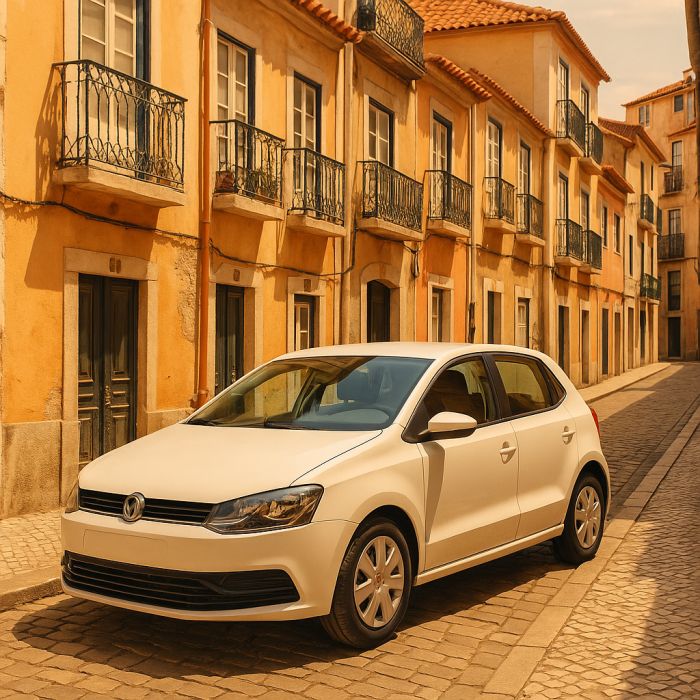- Navigating Portugal’s Historic City Centers — Parking & Driving Tips
- 🚧 Driving in Portugal’s Old Town Centers: What to Expect
- 🅿️ Parking in Lisbon’s Historic Districts with a Rental Car
- 🌉 Parking & Driving in Porto’s Old Town: A Different Challenge
- 🏰 Parking Around Sintra’s Palaces and Castles
- 🌳 Parking in Évora & Coimbra’s Historic Cores
- 💡 Top Tips for Stress-Free Urban Driving in Portugal with Your Rental Car
Navigating Portugal’s Historic City Centers — Parking & Driving Tips
Portugal’s charm lies in its ancient cities, with their labyrinthine streets, charming cobblestones, and centuries of history. While exploring these enchanting old towns by foot is a must, having a rental car gives you the freedom to discover hidden gems and venture beyond the usual tourist trails.

However, driving and parking in these historic centers can be a unique challenge for visitors. Don’t worry! This comprehensive guide will equip you with the knowledge to navigate Portugal’s old towns like a local, avoid fines, and make the most of your car rental experience. ✨
🚧 Driving in Portugal’s Old Town Centers: What to Expect
Before you even think about parking, it’s crucial to understand the driving conditions in Portugal’s historic city centers. They are often very different from modern urban layouts:
- Narrow Streets: Many streets, especially in Lisbon’s Alfama, Porto’s Ribeira, or Sintra’s old village, were built long before cars existed. They are incredibly narrow, sometimes barely wide enough for one car. Take it slow! 🐌
- Cobblestones: While beautiful, cobblestone streets can be bumpy and sometimes slippery, especially when wet. Drive cautiously to maintain control and protect your rental car’s suspension.
- Pedestrian Zones: Many historic areas prioritize pedestrians. Look out for “Zona Pedonal” (Pedestrian Zone) signs, as driving into these areas is strictly prohibited and will result in a hefty fine. 🚶♀️🚫
- One-Way Streets: What looks like a two-way street might actually be one-way, often indicated by small, easily missed signs. Rely on your GPS, but also pay close attention to local signage. ⬆️➡️
- Steep Hills: Cities like Lisbon and Porto are famous for their hills. Be prepared for steep ascents and descents, and use your car’s handbrake effectively when parking on inclines. 🏞️
🅿️ Parking in Lisbon’s Historic Districts with a Rental Car
Lisbon is a vibrant city, but its historic areas like Alfama, Bairro Alto, and Chiado present the biggest parking challenges for rental cars in Lisbon. Here’s how to approach it:
- Residential Parking Zones (Zonas de Estacionamento de Residentes – ZER): You’ll see signs indicating these zones. Non-residents (including rental cars) are typically not allowed to park here or face significant fines and towing. Do NOT attempt to park in these areas. 🚫🚗
- Underground Car Parks (Parques de Estacionamento): This is your best bet for secure and legal parking. Look for blue “P” signs. While more expensive, they offer peace of mind. Popular options include:
- Parque da Baixa-Chiado (for Baixa/Chiado)
- Parque da Praça dos Restauradores (for Avenida da Liberdade/Baixa)
- Parque Portas do Sol (for Alfama/Graça – though still a walk to the deepest parts)
- Parque do Campo das Cebolas (near Alfama)
Expect to pay anywhere from €1.50 to €3.00 per hour, with daily maximums. 💸
- On-Street Paid Parking: In less restricted areas outside the very core historic zones, you might find blue-lined spaces. You’ll need to pay at a nearby meter or via an app (e.g., ePark or Emel). Check the signs carefully for hours of operation and maximum parking durations. ⏰
- Park & Ride: For longer visits, consider parking at a larger car park on the outskirts (e.g., near a metro station like Parque da Luz or Colégio Militar) and using public transport to reach the city center. This can save you money and stress. 🚇
🌉 Parking & Driving in Porto’s Old Town: A Different Challenge
Porto’s Ribeira and other historic districts share similarities with Lisbon but have their own quirks. Driving in Porto’s old town is also characterized by narrow, winding, and hilly streets.
- Limited Parking: On-street parking in the direct Ribeira area is minimal and mostly reserved for residents.
- Recommended Car Parks:
- Parque da Alfândega: A large underground car park near the Douro River, convenient for Ribeira.
- Parque D. João I: Another central option.
- Parque da Trindade: Near the Trindade metro station, good for exploring the city center.
- Driving Restrictions: Be aware of areas with restricted access, especially around popular tourist spots. Follow your GPS, but always cross-reference with road signs.
- Riverfront Access: While beautiful, the riverfront area can get very busy. Consider parking slightly further away and enjoying a walk along the Douro. 🚶♂️
🏰 Parking Around Sintra’s Palaces and Castles
Sintra, a UNESCO World Heritage site, is renowned for its fairytale palaces. While charming, its narrow, winding roads and limited parking can be a nightmare if not planned. Car rental Sintra parking is a top concern for visitors.
- Extremely Limited Parking at Attractions: Parking directly at Pena Palace, Quinta da Regaleira, or the Moorish Castle is severely limited, often full by mid-morning, and can lead to frustration and fines if parked illegally.
- Designated Car Parks in Sintra Village: Look for official paid car parks within Sintra’s historic village.
- Parque de Estacionamento da Portela de Sintra: A larger car park further down, with a shuttle bus or walk into the center.
- Parque de Estacionamento da Corrente: Another option in the village.
- Use Public Transport from Parking: From the main car parks in Sintra town, it’s highly recommended to use the local tourist buses (Bus 434 for Pena Palace/Moorish Castle loop) or walk to reach the attractions. Do NOT try to drive between palaces. 🚌
- Early Arrival: If you absolutely must drive to the vicinity of the palaces, arrive very early (before 9:00 AM).
🌳 Parking in Évora & Coimbra’s Historic Cores
Évora and Coimbra offer beautiful historic centers that are generally more manageable than Lisbon or Porto, but still require attention.
💸 Don’t Overpay at the Airport
Compare real-time rental deals with no hidden fees or credit card needed.
- Évora: The entire historic center is a UNESCO site. On-street parking inside the walls is limited, primarily for residents.
- Recommended Parking: Look for free or paid car parks just outside the city walls. These are typically within easy walking distance. For example, near the Roman Temple or outside Porta de Avis. ✅
- Coimbra: The university city has a steep, hilly historic core.
- Recommended Parking: Park along the Mondego River (e.g., Parque de Estacionamento do Parque Verde do Mondego) or at underground car parks like Parque Mercado Municipal. From there, you can walk or take a bus/taxi up to the university. 🏞️
💡 Top Tips for Stress-Free Urban Driving in Portugal with Your Rental Car
Rely on GPS, but Stay Alert: Your GPS (Google Maps, Waze, or your rental car’s built-in system) is invaluable, but always cross-reference with actual road signs, especially for one-way streets and restricted zones.
Opt for a Smaller Car: A compact or economy car will make navigating narrow streets and finding parking spots significantly easier. They’re literally your best friend in these old towns! 🚗💨
Pre-Book Parking if Possible: Some larger city center car parks allow online pre-booking, which can save you time and guarantee a spot, especially during peak season.
Understand ZOCs (Zonas de Acesso Condicionado): These are “Controlled Access Zones” or “Restricted Traffic Zones.” They are common in historic city centers and are monitored by cameras. Only authorized vehicles (residents, public transport, deliveries) can enter. Entering one by mistake will result in a fine. Look for signs indicating these zones. 📸🚫
Don’t Block Entrances or Garages: Parking illegally, even for a few minutes, can lead to fines or towing. Always respect no-parking signs, yellow lines, and never block private driveways or garages.
Consider Public Transport: For deep dives into the most challenging historic areas, consider parking further out and using Lisbon’s trams (like Tram 28 in Alfama!), funiculars, metro, or local buses. It’s often more relaxing and authentic! 🚋
Tolls (Autoestradas): While not directly related to city driving, remember to understand Portugal’s toll system (Via Verde is highly recommended for rental cars) to avoid unexpected charges.
Driving and parking a rental car in Portugal’s historic city centers might seem daunting, but with a bit of preparation and adherence to local rules, you can confidently explore these beautiful areas. Park smart, drive carefully, and immerse yourself in the rich history and culture of Portugal! Enjoy your journey! 🇵🇹✨




